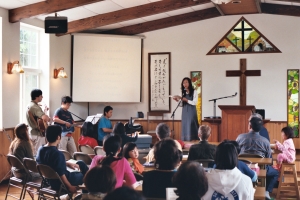 Worship at the morning service
in Itayangi
|
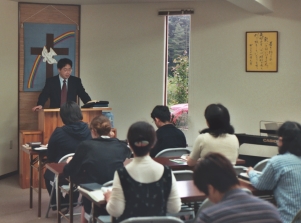 Kanagi Chapel, Takase-sensei preaching.
|
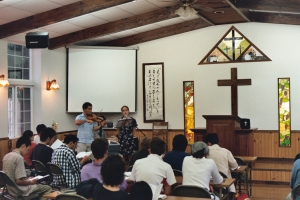 International Chapel. Our
teammate Hannah is on the
right leading vocals. |
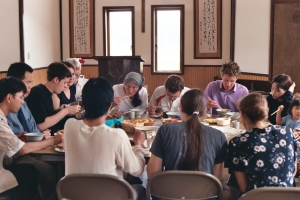 Lunch after the service at Ajigasawa. Unfortunately in order to get Makoto (far left) in the picture, I had to leave out the rest of the Japanese congregation, seated right. |
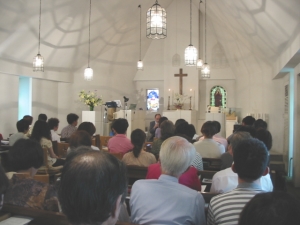 Children’s sermon at the OMF
church in Tokyo.
|
Most of the services we went to were associated with the Tsugaru Church, as it has a number of cell churches. The main Sunday Morning service is in Itayanagi and is in Japanese, with about 30 people in attendance. These vary in age from children who can’t sit still to ageing grandparents. It seemed a distinctly healthy church (in contrast with what I expected to find), full of singles and families that were seeking God. The service was a fairly contemporary service, split between praise songs and hymns. An hour after the service is a church luncheon, which, by church decision, is always curried rice (karii-raisu). A most tasty meal and a good opportunity to talk with members of the church who spoke English.
The next service was the Kanagi Chapel service. Kanagi Chapel is staffed by the Takases, who live above it. Mr. Takase and Mr. Ghent take turns giving the sermon. This is a much more traditional service, with mostly hymns and some choruses sung to the piano. If the pianist, who also goes to the Ajigasawa church cannot make it, then the songs are sung to tape accompaniment. This service has a regular attendance of about seven or eight, although there were about eighteen our first Sunday (including ourselves). Immediately after the service is a fellowship tea (except that everyone drinks coffee) where one or two of us would share our testimony.
The last service of Sunday was the International Chapel, back at Itayanagi. Since this service was described in the section on our relational ministry, I will not describe it much here, except that it had the feel of a InterVarsity large group only with an actual missionary as the speaker (Mr. Ghent and Mr. Elliot spoke on alternating weeks). I always enjoyed this service, since after trying very hard and very unsuccessfully to understand two Japanese services, it was good to be able to worship without wondering what we were saying.
One Sunday we went to the Elliot’s church in Ajigasawa. Although the church looked similar to the Itayanagi church, the service was quite different, being a more traditional, slightly liturgical style service. It was a good deal smaller, too, with about five regular attenders, I think. Since the Elliots brought seven people and we were another four, the service was fairly large. Afterwards we had a pleasant potluck meal and shared about each ourselves with each other.
Of all the churches, the one that felt most “normal” was the OMF church in Tokyo. This was by far the largest church we visited, with about fifty or sixty people. The church was built by a Japanese woman on the spot were her house stopped burning after she prayed; she liked the Western style, so it resembles the stereotypical image of a church. It also has a Western system of greeeters (who can speak English, too). The church is next to OMF Japan headquarters and is pastored by one of the missionaries there. Westerners are apparently frequent, as he provides an English translation to the greeters. After the service is, of course, a fellowship meal. I met a man here who had just finished seminary, while working, and who took me to Shinjuku to find go stones, since he lived in the region. Interestingly, he is married to a Korean woman (they spoke English for the first few years of their marraige) and attends this church because the pastor’s Japanese is very clear, since she is not a native speaker.
I was very encouraged by the Japanese churches. The Tokyo and Itayanagi churches seem like really great churches, churches of which I would love to be a part were I living in the area. The Kanagi and Ajigasawa churches, while small, have some wonderful members and are in good hands with respect to the leadership. Although the description I originally had of churches in Japan may be true in some cases, certainly I saw plenty of churches that God is actively building. However, there are still few churches, and Japan still has a great need for missionaries to lead and start new churches.